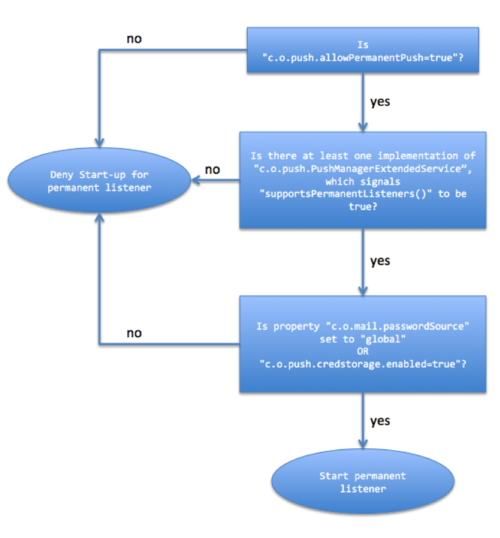Mail Push deprecated
Enable permanent mail push listeners
The existing mail push framework of the Open-Xchange Middleware has been extended by the capability to spawn "permanent" listeners for incoming new message deliveries. Up to that point the life cycle for a listener was bound to at least one active session, which is associated with a client that is allowed to receive mail push notifications.
With introduction of the previously mentioned capability, listeners can be started without the need for an existent session right on the start of an Open-Xchange Middleware node. In addition those permanent listeners are spread approximately even over capable cluster members as - dependent on the underlying implementation - a listener representation may open/hold resources (socket connections) in order to receive notifications about new message deliveries.
To prepare a certain Open-Xchange Middleware node to spawn permanent mail push listeners the following properties need to be configured in file /opt/open-xchange/etc/mail-push.properties:
com.openexchange.push.allowPermanentPushThis is the general switch to enable/disable support for permanent listeners on a node. Thus needs to be set to "true"com.openexchange.push.allowedClientsSpecify the comma-separated list of clients which are allowed to receive notifications about new mails. Ensure that "open-xchange-mobile-api-facade*" is listed here in case new mail push is supposed to be setup for OX Mail v2 0.com.openexchange.push.credstorage.enabledAs permanent listeners are required to run without an active session, the credential storage can be used to store user credentials in installations that do not support a master authentication to the mail storage. Hence, if the propertycom.openexchange.mail.passwordSource(/opt/open-xchange/etc/mail.properties) is not set to "global" this property is required to be set to "true"com.openexchange.push.credstorage.passcryptThis property is required ifcom.openexchange.push.credstorage.enabledis set to "true". It does specify the passphrase to use to symmetrically encrypt the stored credentials. The passphrase is required to be equal on each cluster member.com.openexchange.push.credstorage.rdbOnce the credential storage is enabled, Open-Xchange offers two ways of storing the user-associated login/password combination. In cluster memory (default) or persisted to database. While the first way ensures that no user credentials are persisted anywhere in the Open-Xchange installation, it has the big disadvantage that stored credentials are gone once the last cluster member gets shut-down. Therefore there is also the possibility to store the credentials inside the database. Of course, no matter where the credentials are stored, they are encrypted using the value fromcom.openexchange.push.credstorage.passcryptproperty
With setting the properties above the configuration on the Open-Xchange Middleware node is prepared to spawn permanent listeners for new mails.
Now an appropriate mail push bundle/package needs to be enabled that supports spawning permanent listeners. Currently Open-Xchange ships with three implementations:
open-xchange-push-dovecot(also requires the optional open-xchange-rest package)open-xchange-push-imapidle(Not recommended, therefore disabled for permanent listeners by default:com.openexchange.push.imapidle.supportsPermanentListenersis set to "false" by default)open-xchange-push-mailnotify
This article is focussed on open-xchange-push-dovecot. Packages can be enabled in your chart's values.yaml:
core-mw:
packages:
status:
open-xchange-push-dovecot: enabled
Putting all together the following execution flow is taken to decide whether permanent listeners are spawned or not:

To check at any time what listeners are currently running, there is a new command-line tool /opt/open-xchange/sbin/pushusers that outputs the user-id/context-id pair along-side with the information if the listener is of permanent nature or bound to an active session:
usage: pushusers [-l | [ -r -c <contextId> -u <userId> -i <client>] ] -A <masterAdmin> -P <masterAdminPassword> [-p
<RMI-Port>] [-s <RMI-Server>] [--responsetimeout <responseTimeout>] | [-h]
-A,--adminuser <adminUser> Admin username
-c,--context <contextId> A valid context identifier
-h,--help Prints this help text
-i,--client <clientId> The client identifier
-l,--list-client-registrations Flag to list client registrations
-p,--port <rmiPort> The optional RMI port (default:1099)
-P,--adminpass <adminPassword> Admin password
-r,--unregister Flag to unregister a push user
--responsetimeout <timeout> The optional response timeout in seconds when reading data from server (default: 0s;
infinite)
-s,--server <rmiHost> The optional RMI server (default: localhost)
-u,--user <userId> A valid user identifier
Command-line tool for unregistering and listing push users and client registrations
An exemplary out put might look like:
~# /opt/open-xchange/sbin/pushusers --list -A oxadmin -P secret
Context User Permanent
1 249 true
1 402 true
Setup Dovecot Mail Push
Please see here
Setup Push Notification Service
Please see here.
